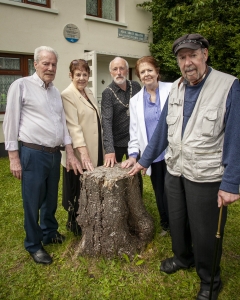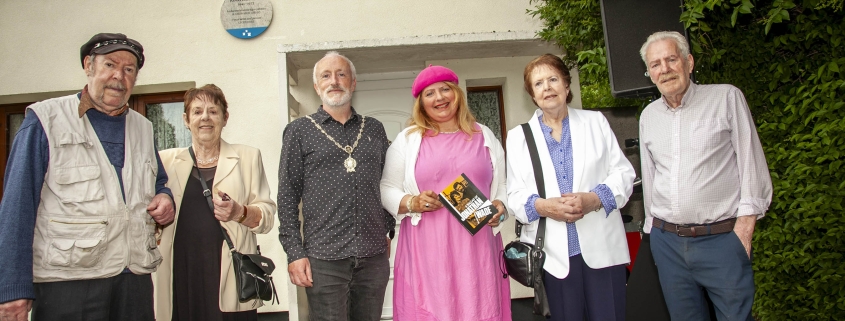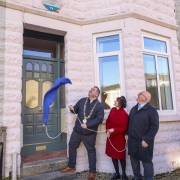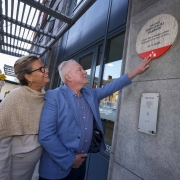Plaque dedicated to Visual Artist and Painter Jonathan Wade unveiled
This morning a plaque was unveiled to commemorate the visual artist and painter Jonathan Wade at his home in 2 Walkinstown Avenue.

Cllr Ray Cunningham (deputising for the Lord Mayor) with Jonathan Wade’s siblings Robert Wade, Jean Guidon, Kathleen Courtney and Tommy Wade.
Jonathan Wade was a Dublin-born Irish artist renowned for his evocative urban and industrial landscapes. He has been described as possibly the finest Irish visual artist of the last century. It was while living in Walkinstown in his teenage years that John began to develop a passion for painting, and this is where he painted many of his earliest works.
Born on Thomas Street in 1941, Jonathan Wade was the eldest son of Thomas and Sarah Wade. The family moved from Thomas Street to Basin Lane around 1943 and then on to 2 Walkinstown Avenue in 1952.
Following a visit to see his mother in Walkinstown, Jonathan was on his way home to Clondalkin when he was tragically killed in a motorcycle accident on the Monastery Road in the early hours of 22nd of January 1973. He was only 31.
Owing to his powerful and heartfelt urban landscapes, at the time of his death, Jonathan was fast on his way to becoming recognised as a painter of great stature and skill, both in Ireland and internationally. John Wade (known as Jonathan after 1962) possessed extraordinary artistic prowess, excelling in both imaginative concepts and skilful execution. He had no interest in painting emotive, picturesque scenes, but rather sought to portray an overwhelming sense of industrial catastrophe by painting large images of decaying and rusted buildings and machinery. His interest in Marxism and left-wing politics had a profound impact on his creative output.
Wade’s first solo exhibition was held in the Fergus O’ Farrell studios in 1966, followed by the Royal Hibernian Academy in 1968. His largest and most important solo exhibition was held in the Project Arts Centre on Abbey Street in 1970, with a collection of thirty-seven paintings on show. At this point in his life, Wade had been spending time in Dublin’s dockyards, submerging himself in the landscape of the city. This led to the creation of a series of paintings depicting landscapes of rusted metal junk – a crumbling, industrial world.
Jonathan Wade is represented in the collections of the Dublin City Gallery The Hugh Lane and The Arts Council / An Chomhairle Ealaíon.
Speaking at the unveiling, Cllr Ray Cunningham, deputising for the Lord Mayor of Dublin said, “I am honoured to be here on a day when such an influential figure in our cultural heritage is being recognised. As public representatives and communities our focus has moved since Jonathan Wade’s time, we are better at improving our cityscapes and protecting our environment. It is also important that we protect the heritage of the watcher, the man whose images of twisted metal and broken concrete wilderness marked out his reputation as one of the great visual artists of the last century.”
“If there are to be doers, there must be see-ers. The eye of the artist is a treasure and a resource that our city should cherish and celebrate. That is what we have a valuable opportunity to do today,” he continued.
The decision to erect the plaque was made by the Dublin City Council Commemorations & Naming Committee, whose chair, Deputy Lord Mayor Councillor Donna Cooney, said, “The Commemorative Plaques Scheme allows the City to formally commemorate people who have made a significant contribution to the life of Dublin. We welcome suggestions from the public for people and events to be commemorated. Full details are on the Council website.”
Notes to the editor:
Dublin City Council’s Commemorative Plaques Scheme is intended to facilitate the formal commemoration of people, organisations, and events that have made a unique and significant contribution to the life or history of Dublin through outstanding achievement, distinctive service or significant community contribution.
Proposals to commemorate living persons will not be considered.
Nominees must have died at least 20 years previously or have passed the centenary of their birth, whichever is earlier.
Members of the public can propose a commemorative plaque on the official form.
Full details, including the application form and the list of plaques erected so far, can be found at www.plaquesofdublin.ie













